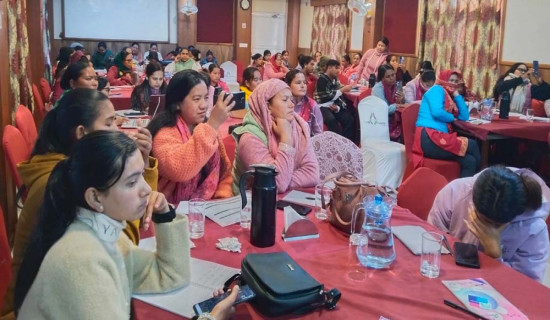- Thursday, 25 December 2025
Advance Community-Led HIV Response
Jhabindra Bhandari
There are increasing evidences that community-led responses to HIV result in positive health outcomes and enhance community resilience. Considering the emerging trends of key populations-led HIV response, meaningful and inclusive participation of civil society is critical to connect the marginalised communities with services and ensure that no one is left behind.
Priority
Placing key populations at the centre of HIV response is instrumental in empowering the communities in participatory planning, implementation, monitoring and evaluation of comprehensive HIV services. While this approach has gained significant momentum in recent years, more focus is needed to harness the capacity building opportunities of civil society networks in order to advance sustained community-led HIV responses.
On the other side, concept of community-led monitoring of HIV services is a high priority agenda in national response. This concept is particularly important in terms of improving accessibility, responsiveness and quality of HIV services. And the strategic approach of community-led monitoring greatly enhances social mobilisation by building community linkages with other health actors.
The role of partners such as UNAIDS, PEPFAR, USAID, FHI 360, the Global Fund and few others is crucial to enhance the capacity of the governments and civil society networks in scaling up of the community-led HIV services to meet the ambitious 95-95-95 targets. Similarly, it is crucial to periodically review the implementation of strategic interventions as envisioned in the national HIV strategic plan (2021-2026).
Over the years, there has been remarkable progress in advocacy, campaigning and participation of civil society networks in decision-making, monitoring and accountability processes. In strategic planning and periodic reviews of national HIV programme, a range of participatory and inclusive consultations with key populations and relevant stakeholders have been effective in addressing the needs and challenges of key populations in accessing HIV services. The Global Fund has been supporting different countries to strengthen the engagement of civil society and communities affected by HIV, TB and malaria. In this context, some of the important areas of the support include situation analysis, needs assessment and social contracting mechanisms that broadly aim to strengthen resilient community and health systems in a holistic approach.
Considering the continuity and sustainability of community-led HIV services, the on-going efforts to design robust, transparent and accountable mechanisms for all levels of governments to channel funds to civil society networks are relevant, but limited to large extent. There are opportunities and challenges of public financing mechanisms to civil society networks because of new federal polices, strategies and regulatory frameworks.
In the changing scenario of epidemiological landscape, civil society networks have an indispensable role to play in improving equitable access to quality services and contributing to comprehensive health care. For example, community-based antiretroviral therapy (ART) has been an essential activity for client-centred HIV service delivery during COVID-19 or other health emergencies due to natural disasters.
Worryingly, COVID-19 continues to threaten the gains made in the HIV response and has brought inequalities to the forefront. However, it is encouraging to note that civil society networks in Asia and the Pacific have been profoundly engaged in community-led responses to the pandemic. However, there are critical needs of undertaking implementation research to generate fresh evidences so that most efficacious interventions can be designed to address the existing gaps of service coverage in the communities. Unfortunately, there are limited implementation research interventions. Again, sociological and anthropological perspectives can help the policymakers and service providers to better understand the diverse views, concerns and emerging needs of key populations.
Accountability
More importantly, the cultural systems, social inequality and political economy are enormously shaping the vulnerability to HIV infection. Therefore, interdisciplinary approach is needed to integrate both cultural and structural concerns in HIV response. This will be instrumental in advocating for an enabling environment and programming to reduce human rights and gender-related barriers in HIV response.
After all, the ownership and accountability of the governments, civil society and all relevant partners is the key to ending AIDS as public health threat by 2030. Implementation of rights-based and innovative community-led interventions is extremely important to yield profound impacts on the lives of key populations and people living with HIV. More importantly, there are emerging needs of concerted efforts to substantially reduce the inequalities caused by socio-economic, cultural, psychological, geographical and political barriers in accessing quality HIV services.
(PhD in global health, Bhandari writes on health and development issues.)

















